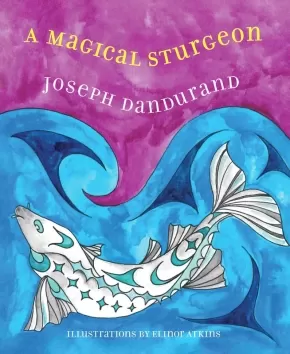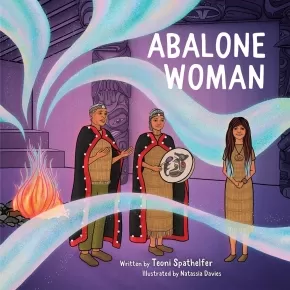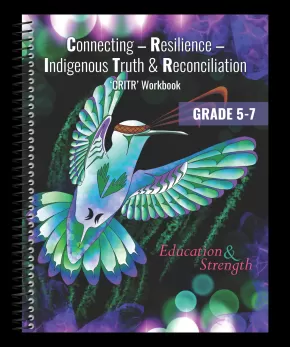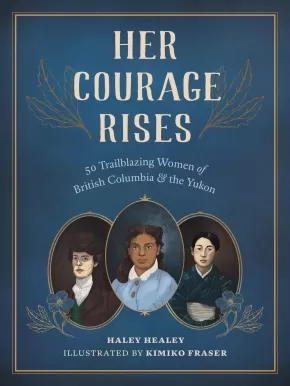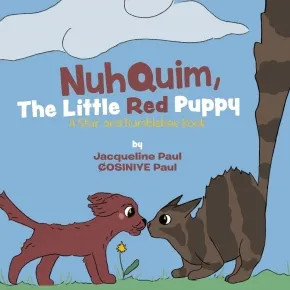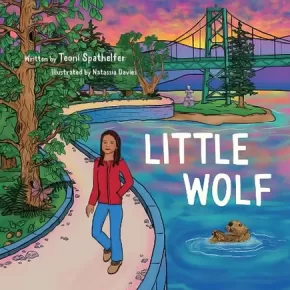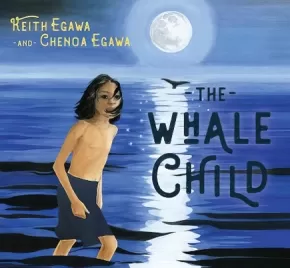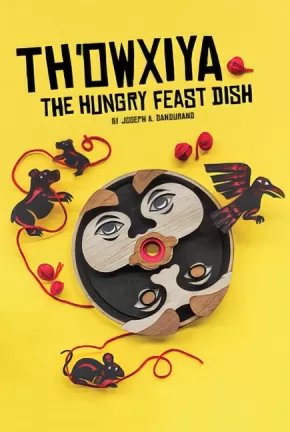
Coast Salish
31
-
45
of
74 Results;
Sort By
Go To
of 5
A Magical Sturgeon
$15.95
Artists:
Format:
Paperback
Text Content Territories:
Indigenous Canadian; First Nations; Salish; Coast Salish; Sto:lo; Kwantlen;
ISBN / Barcode: 9780889713901
Synopsis:
Synopsis:
Written and illustrated in the tradition of the Kwantlen people, Joseph Dandurand's second book is an endearing tale of two sisters and their connection with nature.
In the water sat a sturgeon, born there, so they say, thousands of years ago, though the sturgeon themselves have been here for two hundred million years. It was at first a little egg, a big egg, born into the river. Now the sturgeon is back but how did it get here? How did the first sturgeon come to be? Earth and the river, moons and suns and clouds. Time, thousands of years and the Skwó:wech has seen it all. But what gift does the sturgeon have for us?
So begins this second charming story for children by Kwantlen storyteller Joseph Dandurand. The sturgeon, spirit of the great river, eludes human fishers until two young sisters neglect to follow their mother’s instructions. What follows provides a moving exploration of the importance of sharing and kinship with all other living things.
The story is told with grace and simplicity by a master storyteller in the great tradition of the Kwantlen people. Accompanied by Elinor Atkins’s illustrations, A Magical Sturgeon is a touching follow-up to Dandurand’s bestselling children’s book The Sasquatch, the Fire and the Cedar Baskets.
Educator Information
Recommended for ages 6 to 8.
This is the second book in the Kwantlen Stories Then and Now series.
Additional Information
32 pages | 7.00" x 8.50" | Paperback
Abalone Woman (PB)
$12.95
Artists:
Format:
Paperback
Text Content Territories:
Indigenous Canadian; First Nations; Heiltsuk (Bella Bella);
ISBN / Barcode: 9781772034271
Synopsis:
Synopsis:
A vivid dream teaches Little Wolf about courage and acceptance of those who are different, and inspires her to show her daughters and their classmates how to be proud of their diverse cultural backgrounds.
Throughout her life, Little Wolf has been troubled by the injustice she sees all around her. When she was young, she was bullied for her Indigenous heritage. Her mother, White Raven, spent ten years in a residential school, separated from her family and isolated from her culture. Little Wolf’s own children are growing up in a different, more open society, but hatred and racism still exist. Little Wolf worries about the world her daughters will inherit. One night, a vivid dream helps her realize her own strength as a leader and peacemaker in her community. Told with powerful imagery and symbolism, Abalone Woman is the third book in the Little Wolf series, which presents themes of racism, trauma, and family unity through relatable, age-appropriate narratives.
Educator & Series Information
Recommended for ages 4 to 8.
This is the third book in the Little Wolf series.
This book is available in French: Femme Ormeau
Additional Information
32 pages | 9.00" x 9.00" | Paperback
Connecting – Resilience – Indigenous Truth & Reconciliation ‘CRITR’ Workbook: Grade 5 - 7
$29.95
Artists:
Format:
Coil Bound
Text Content Territories:
Indigenous Canadian; First Nations; Inuit; Métis;
ISBN / Barcode: 9781990448348
Synopsis:
Synopsis:
CRITR provides dozens of lessons and 100s of questions covering important topics including: Indigenous Canadian History, Residential Schools, Indigenous Contributions past and present, Treaties, and Indigenous Days of Recognition in Canada.
This book is a collection of parts of the history of the Indigenous Peoples in Canada and of the process of reconciliation. It is designed to educate all children and youth -- our future leaders -- about Indigenous history and current events. It is intended to give a better understanding and to positively contribute to reconciliation.
Together, we must consider the past, the present, and the future in our efforts to better ourselves and future generations.
This book provides a wealth of high-quality articles and learning activities, consisting of units and lessons that can be used by anyone -- teachers, parents, students, business professionals -- who may have little or no prior knowledge or understanding of Indigenous Peoples or subjects.
In this book, you will meet real Indigenous Peoples speaking out and sharing their stories and their firsthand experiences, and you will clearly hear their passion for reconciliation.
This book is unique. The stories told within its covers are unique, just like everyone working through their own journey of understanding and doing their small part towards reconciliation.
“We need to pursue reconciliation consistently and passionately. Education has gotten us into this mess, and education will get us out. We see this as our challenge and our hope.” -The Honourable Senator Murray Sinclair
Educator Information
Recommended for grades 5 to 7.
CRITR Workbook Features
- Indigenous knowledge from different Indigenous Peoples and Indigenous perspectives.
- Dozens of lessons covering important topics including Residential Schools, Treaties, and Indigenous Contributions.
- Beautiful original art on the cover and throughout the book.
- An Indigenous worldview expressing people's need to develop themselves and their children, in a way that addresses their spiritual, physical, emotional, and mental gifts.
- An approach to the teaching and healing process that is interconnected and cyclical in nature.
- An introduction to readers of the concept of a "sacred circle," also known as a medicine wheel, as well as First Peoples' principles of learning in general terms.
- Words of encouragement.
- A balance between too much and too little content.
- Information and a layout to inform and inspire without overwhelming the teacher or the student, in the classroom or at home.
- Fresh insights and learning activities for key Indigenous events that are celebrated annually in schools and communities across the Nation.
- Critical thinking questions to inspire new learning.
- Activities for individuals and groups.
- The font in the grade 5 to 7 book is ideal for young readers ( Arial 13.5-point font). Additionally, the grade 5 to 7 book features shorter sentence structure for easy reading and comprehension.
- A few activities and lessons featured in the grade 8 to 12 resource have been changed or removed in the grade 5 to 7 book due to the maturity level of the subject matter.
- Grade-level appropriate word choices to help with improved vocabulary.
How is the CRITR workbook organized?
Each lesson follows this pattern:
- An easy-to-read lesson that may be read in under 5 minutes
- A vocabulary focus called Word Power that defines key words from the lesson
- A set of questions easily answered from the reading
- A Critical Thinking section is included to enhance learning
- Sprinkled throughout the CRITR Workbook are relevant individual and group activity recommendations.
Additional resources are identified throughout the pages with links, including information about how to connect with the Indigenous authors and artists.
Activities, colouring, and word search pages may be downloaded for free. An answer key is included at the end of the book.
What will students learn from this resource?
- Reconciliation is about change, justice, respect, and re-building the relationships between the Indigenous and non-Indigenous Peoples in Canada
- Indigenous History of Canada
- Empathy that comes from understanding and being educated
- Knowledge about important and sensitive topics, including stories told by Indigenous authors about what occurred at residential schools. It is important to know these stories of assimilation
- Capacity for intercultural understanding, empathy, and mutual respect as prescribed specifically in CTA #63
Educator Information
For grades 5 to 7.
A $5 per book discount is applied to a purchase of 10 or more books.
This book is available in French: Connexion - Résilience - Vérité et réconciliation autochtones Ressource - 5e à 7e année
Additional Information
176 Pages | 9" x 11.5" x 0.5" | Spiral Bound
Her Courage Rises: 50 Trailblazing Women of British Columbia and the Yukon
$22.95
Artists:
Format:
Hardcover
Text Content Territories:
Indigenous Canadian; First Nations; Anishinaabeg; Ojibway; Haida; Haudenosaunee (Iroquois); Kanyen'keha:ka (Mohawk); Kwakwaka'wakw (Kwakiutl); Da'naxda'xw Awaetlala; Nuu-chah-nulth (Nootka); Salish; Coast Salish; Cowichan; Tagish; Tlingit; Métis; Indigenous Hawaiian;
ISBN / Barcode: 9781772034257
Synopsis:
Synopsis:
A beautifully illustrated collection of inspiring life stories of fifty extraordinary historical women from BC and the Yukon.
This fascinating, informative, and charming book introduces young readers to a diverse group of women who changed the face of history in unexpected ways and defied the expectations and gender norms of their times. Through charming illustrations and concise biographies, Her Courage Rises features social activists and politicians, artists and writers, scientists and healers, pioneers and prospectors, athletes and entrepreneurs, teachers and cultural tradition keepers.
These women represented all ages, walks of life, and backgrounds. Some, like Cougar Annie and shipwreck heroine Minnie Paterson, became legendary in popular culture, long after their deaths. Others, like politician Rosemary Brown, artist Emily Carr, and Olympic sprinter Barbara Howard, achieved fame during their lives. Still others, including photographer and cultural teacher Elizabeth Quocksister, artist and cultural consultant Florence Edenshaw, land claims activist and translator Jane Constance Cook (Ga’axsta’las), and language champion Barbara Touchie, made great strides in preserving and promoting Indigenous rights and cultures. And many, like environmentalist Ruth Masters, water diviner Evelyn Penrose, and Doukhobor pioneer Anna Markova, are less well-known but still made important contributions to their communities and our wider collective history.
Her Courage Rises is full of inspirational female role models and insights into the trailblazing women who made history in BC and the Yukon.
Reviews
"[An] extra-textual approach blended with rigorous traditional research allowed Healey and Fraser to create a fresh and unique historical document – one that not only gives fascinating detail, but manages to capture an ineffable humanity and relatability in even the most exceptional people profiled."
Quill & Quire
“This easily approachable book is a celebration of the achievements of fifty women who had the determination and strength of character to fashion new directions, sometimes despite great odds. Their stories represent hope and courage and serve as a reminder that women have always played a defining role in shaping their societies.”—Cathy Converse, author of Following the Curve of Time and Against the Current: The Remarkable Life of Agnes Deans Cameron
"Haley Healey has written another very important book highlighting the achievements of many women in history. This short book, beautifully illustrated by Kimiko Fraser, will be one to treasure in your favourite historical non-fiction collection."—Valerie Green, historian and author of If More Walls Could Talk: Vancouver Island’s Houses from the Past
“An engaging book that encourages the interest of young readers by providing a factual way in to explore diverse lives. By reframing unorthodox lives and breaking down stereotypes, the author highlights the resilience and determination of her subjects, made more tangible through the illustrations.”—Linda J. Eversole, author of Victoria Unbuttoned: A Red-Light History of BC's Capital City and Stella: Unrepentant Madam
Educator Information
Recommended for ages 12+
Additional Information
128 pages | 7.00" x 9.00" | Hardcover
NuhQuim, The Little Red Puppy: A Star and Bumblebee Book
$19.32
Artists:
Format:
Paperback
Text Content Territories:
Indigenous Canadian; First Nations; Salish; Coast Salish; Saanich (WSANEC); Tsartlip;
ISBN / Barcode: 9780228870616
Synopsis:
Synopsis:
What would you do if your mum brought home a new puppy? Jump for joy? Squeal with delight? Hold that puppy oh so tight?
Find out how NuhQuim, the Little Red Puppy, stirs things up for three young Indigenous children! Set on Vancouver Island in British Columbia, Canada, follow NuhQuims true story of how he touches three siblings with his fur, fangs, and flare!
Educator Information
The publisher recommends this title for ages 12 and under.
Includes an Author's Note and Glossary.
Additional Information
34 Pages | 8.5 " x 8.5" | Paperback
The Witness Blanket: Truth, Art and Reconciliation
$24.95
Format:
Hardcover
Text Content Territories:
Indigenous Canadian;
ISBN / Barcode: 9781459836129
Synopsis:
Synopsis:
For more than 150 years, thousands of Indigenous children were taken from their families and sent to residential schools across Canada.
Artist Carey Newman created the Witness Blanket to make sure that history is never forgotten. The Blanket is a living work of art—a collection of hundreds of objects from those schools. It includes everything from photos, bricks, hockey skates, graduation certificates, dolls and piano keys to braids of hair. Behind every piece is a story. And behind every story is a residential school Survivor, including Carey's father. This book is a collection of truths about what happened at those schools, but it's also a beacon of hope and a step on the journey toward reconciliation.
Educator Information
Recommended for ages 9 to 12.
Additional Information
112 pages | 7.50" x 9.00" | Hardcover
White Raven (PB)
$12.95
Artists:
Format:
Paperback
Text Content Territories:
Indigenous Canadian; First Nations; Heiltsuk (Bella Bella);
ISBN / Barcode: 9781772033786
Synopsis:
Synopsis:
Little Wolf, grown up with children of her own, moves to the country where her mother, White Raven, shares a sad story from her childhood.
All grown up with a family of her own, Little Wolf moves from the big city to the island of her ancestors. She wants to share the beauty and mysteries of nature with her children, and she wants them to learn as much about their culture as possible. One day, Little Wolf’s mother, White Raven, visits and begins to tell her grandchildren stories from her own childhood. But the stories are not happy ones. As a child, White Raven left her family to attend St. Michael’s Residential School in Alert Bay, BC. While there, she experienced hunger, loneliness, shame, and isolation from her language and her culture. Even years later, as a grown woman and Elder, she has nightmares about her time at the school. But by sharing her story with Little Wolf and her grandchildren, White Raven begins to heal and brings the family closer together. Through simple, heartfelt text and vivid illustrations that combine contemporary and traditional Indigenous motifs, White Raven is an engaging teaching tool as well as a relatable narrative about the impact of intergenerational trauma on families. Based on the author’s own life and her mother’s residential school experience, the central message of this book is one of healing and family unity.
Educator & Series Information
Recommended for ages 4 to 8.
This is the second book in the Little Wolf trilogy.
This book is available in French: Corbeau Blanc
Additional Information
32 pages | 9.00" x 9.00" | Paperback
Elvis, Me, and the Lemonade Stand Summer
$13.95
Format:
Paperback
Text Content Territories:
Indigenous Canadian; First Nations; Salish;
ISBN / Barcode: 9781770866157
Synopsis:
Synopsis:
It’s the summer of 1978 and most people think Elvis Presley has been dead for a year. But not eleven-year-old Truly Bateman – because she knows Elvis is alive and well and living in the Eagle Shores Trailer Park. Maybe no one ever thought to look for him on an Indigenous reserve on Vancouver Island.
It’s a busy summer for Truly. Though her mother is less of a mother than she ought to be, and spends her time drinking and smoking and working her way through new boyfriends, Truly is determined to raise as much money for herself as she can through her lemonade stand … and to prove that her cool new neighbour is the one and only King of Rock ‘n’ Roll. And when she can’t find motherly support in her own home, she finds sanctuary with Andy El, the Salish woman who runs the trailer park.
Awards
- Winner of the 2021 City of Victoria Children's Book Prize
Educator & Series Information
Recommended for ages 9-12 (middle-grade read).
Content Warning: Use of a term from the era of the book, "Indian," is used occasionally.
DCB Young Readers has created a teacher's guide for this work, which can be downloaded here: Teachers Guide - Elvis, Me and the Lemonade Stand Summer
This is the first book in the Elvis, Me, and the Eagle Shores Trailer Park series.
Additional Information
192 pages | 5.37" x 8.00"
Little Wolf (PB)
$12.95
Artists:
Format:
Paperback
Text Content Territories:
Indigenous Canadian; First Nations; Heiltsuk (Bella Bella);
ISBN / Barcode: 9781772033809
Synopsis:
Synopsis:
A young Indigenous girl moves to the big city and learns to find connections to her culture and the land wherever she goes, despite encountering bullies and feelings of isolation along the way.
When Little Wolf moves to the big city with her mom and sister, she has difficulty adjusting to their new life. She misses living close to nature and seeing animals wherever she goes, and she misses fishing with her grandfather and seeing dolphins leaping beside their boat. Most of all, she misses feeling connected to her culture.
At school, Little Wolf has trouble fitting in. Although her class has kids from many different cultures, no one is Heiltsuk, like her. The other kids call her names and make her feel unwelcome. Her only defence is to howl like a wolf so they run away. But this only isolates her further.
Gradually, Little Wolf starts to see the beauty in her new surroundings. She discovers that there is wildlife everywhere, even in the big city. An otter swims beside her as she walks on the seawall. A chickadee chirps in a tree in the big park near her house. And her mother helps her stay connected to their culture by signing them up for beading and dance classes. Despite the difficult start, Little Wolf grows up proud of her background and ready to face the future. This inspiring tale, the first in a trilogy, combines traditional and contemporary Indigenous themes and artwork.
Educator & Series Information
Recommended for ages 4 to 8.
This book is a part of the Little Wolf trilogy.
This book is available in French: Petit Loup
Additional Information
32 pages | 9.00" x 9.00" | Paperback
Stand Like a Cedar
$21.95
Artists:
Format:
Hardcover
Text Content Territories:
Indigenous Canadian; First Nations; Salish; Interior Salish; Nlaka'pamux (Thompson); Coast Salish; Sto:lo;
ISBN / Barcode: 9781553799214
Synopsis:
Synopsis:
When you go for a walk in nature, who do you see? What do you hear?
Award-winning storyteller Nicola I. Campbell shows what it means “to stand like a cedar” on this beautiful journey of discovery through the wilderness. Learn the names of animals in the Nłe7kepmxcín or Halq’emeylem languages as well as the teachings they have for us. Experience a celebration of sustainability and connection to the land through lyrical storytelling and Carrielynn Victor’s breathtaking art in this children’s illustrated book.
Discover new sights and sounds with every read.
Reviews
"Stand Like a Cedar is a work of grace and dignity, a celebration of land, family, and knowing who you are and where you come from and being so grateful for everything you’ve been given. Bravo, Nicola Campbell and Carrielynn Victor for creating this treasure. I love it."—Richard Van Camp, author of Little You and A Blanket of Butterflies
"Campbell’s rhythmic writing is wonderful, conveying important messages about the environment and family. Victor’s vibrant renderings accompany the engaging text nicely. Bold illustrations portray elements such as weather, nature, and animals alongside evocative details like glowing skylines. An Indigenous girl shares vivid lessons in this lovely, thoughtful environmental tale." —Kirkus Reviews
"Stand Like a Cedar is a story that connects the journey of building connections through a journey in the wilderness. Through the blended use of the Nłeʔkepmxcín and Halq'emeylem languages, readers are exposed to the healing that takes place in nature. The lyrical storytelling celebrates the healing and strength that comes from building one’s connections to their own journey." - The Dalai Lama Center
Educator Information
Recommended for ages 6 to 9.
Learn the names of animals in the Nłe7kepmxcín or Halq’emeylem languages as well as the teachings they have for us.
Includes a glossary of phrases and a translation guide.
Includes a page of back matter on Coastal and Interior Salish Languages.
This book is available in French: Debout comme un grand cedre
Additional Information
40 pages | 8.12" x 7.75"
The Sasquatch, the Fire and the Cedar Baskets
$15.95
Format:
Paperback
Text Content Territories:
Indigenous Canadian; First Nations; Salish; Coast Salish; Sto:lo; Kwantlen;
ISBN / Barcode: 9780889713765
Synopsis:
Synopsis:
“Deep in the thickest part of a cedar forest there lived a young Sasquatch. He was over nine feet tall and his feet were about size twenty. He had long brown hair that covered all of his body. His hands were so big and his arms so long he could wrap them around the biggest of the cedar trees. He had been born here many years ago and he did not know his parents, as they had been scared away by a great fire. He was left on his own and he had survived by eating berries and he had grown into the Sasquatch he now was...”
So begins this charming story for children by Kwantlen storyteller Joseph Dandurand. The Sasquatch, spirit of the great cedar forest, eludes human hunters, falls in love, fathers a lovely daughter and saves his little family from a forest fire by dousing the flames with water stored in baskets carefully woven by his mate.
The story is told with grace and simplicity by a master storyteller in the great tradition of the Kwantlen people. Accompanied by whimsical illustrations from Kwakwaka’wakw artist Simon Daniel James, The Sasquatch, the Fire and the Cedar Baskets follows a similar style to popular titles such as Salmon Boy, Mayuk the Grizzly Bear and How the Robin Got Its Red Breast.
Educator & Series Information
Recommended for ages 6 to 8.
This is the first book in the Kwantlen Stories Then and Now series.
Additional Information
32 pages | 7.00" x 8.50"
The Whale Child
$25.95
Format:
Paperback
Text Content Territories:
Indigenous American; Native American; Salish; Coast Salish;
ISBN / Barcode: 9781623174866
Synopsis:
Synopsis:
An inspiring children's book that introduces young readers to the environmental challenges facing the planet through the eyes of Coast Salish characters and authors
"You have family on land as you do in the sea. . . being a caretaker of the earth begins with taking care of the water that all life depends on."
Shiny is a whale child. One day his mother teaches him about the harm facing the world's oceans because of human carelessness. Shiny agrees to be turned into a boy by the ocean's water spirit so he can visit the land and alert people to these dangers. He meets Alex, a young Coast Salish girl who learns from Shiny that the living spirit of water exists in everything--glaciers, rivers, oceans, rain, plants, and all living creatures. Together the two travel the earth, confronting the realities of a planet threatened by an uncertain future. Inspired by Shiny's hope, humor, and wisdom, Alex makes the promise to become a teacher for future generations. She realizes that the timeless Indigenous value of environmental stewardship is needed now more than ever and that we must all stand up on behalf of Mother Earth.
Written and illustrated by Indigenous authors Keith Egawa and Chenoa Egawa, The Whale Child introduces children ages 7 to 12 to existing environmental issues with a message of hope, education, sharing, and action. Also included are resources for students and teachers to facilitate learning about Pacific Northwest Indigenous cultures and the environment.
Reviews
"Vivid illustrations juxtapose the beauty and scale of the natural world that the children explore. . . . This necessary read decolonizes the Western construction of climate change." —Kirkus Reviews (starred review)
"The sacred art of Indigenous storytelling is beautifully upheld in The Whale Child. It teaches us of our relationship with the living Earth, about balance and respect and the responsibilities that we hold toward one another across species. The story guides the reader using traditional Coast Salish lore in a contemporary narrative, masterfully weaving the timeless wisdom of Indigenous ways of knowing into our current reality. The whale child's journey is taken for us all. We must bear witness.” —Sherri Mitchell Weh’na Ha’mu Kwasset, author of Sacred Instructions
“Those of us with hands and feet (alas) who self-identify as members of the Earth’s Whale Tribe now have a new wonderful, strong, kind, and happy tale to represent us, and with which to remember our connection to All Things by. The Whale Child provides that ‘smart step in the right direction’ we all need.”—Paul Owen Lewis, author and illustrator of Storm Boy and Frog Girl
“The Whale Child is an environmental fable for our time. This is the story of Alex, daughter of a mixed Coast Salish and Polynesian family and Shiny, a whale turned briefly human to impart the wisdom of the ocean to humanity. The book is at turns educational, poignant, warm, sad, and funny. Chenoa and Keith Egawa’s delicate watercolor illustrations evoke the chill water, crisp air, and glowing sunshine of the beautiful Salish Sea. . . . The Whale Child is an important book for children, parents, and teachers to read and ponder.” —Bryn Barnard, author of The New Ocean
“A long time ago, we didn’t have to be taught that everything has a spirit, a life force, a memory, a moment that all things came into existence. . . . Brother and sister Keith and Chenoa Egawa bring us back to those teachings in their story The Whale Child. . . . We learn how to quiet our minds to hear the message that mother earth holds the cure, the answers, and the way to heal her if we just take a moment to reconnect and hear what she has to say.”—Janine Gibbons, Haida artist and children's book illustrator for Baby Raven Reads series, Sealaska Heritage Institute
“For the Coast Salish people, the nonhuman living world is not filled with resources to be abused and extracted—rather, these are our relatives that carry our original instructions. . . . Promoting these concepts and the necessary fusion of Indigenous ecological perspectives with western understandings is the fully realized mantra narrated for us in this marvelous story. The critical insights of our responsibilities and the truth of reciprocity—particularly with water, the first medicine—are woven into each page. Through playful adventure, the essence of ancient instructions emerges in the context of a modern world.”—Valerie Segrest, Muckleshoot, author, Native food systems strategist and wild medicine expert
Educator Information
Recommended for ages 7 to 10.
Includes colour illustrations. Beginner's chapter book.
"The story is followed by extensive backmatter: a glossary of environmental terms, a brief history of the Pacific Northwest Native cultures, classroom learning activities, and ideas for student projects. Infusing qualities of traditional storytelling into the narrative, Keith Egawa (Lummi) and Chenoa Egawa (Lummi and S’Klallam) offer a perspective on climate change from the lens of Indigenous people. By relating the tale through the eyes of children, the author-illustrator team evokes an empathy that should stir a wide audience." - Kirkus Reviews
Additional Information
136 pages | 7.00" x 6.49"
If Instead of a Person
$14.00
Artists:
Format:
Paperback
Text Content Territories:
Indigenous Canadian; First Nations; Salish; Coast Salish;
ISBN / Barcode: 9780995012769
Synopsis:
Synopsis:
If Instead of a Person imaginatively explores the wisdom to be learned from living as a tree. Using child-friendly rhyming verse, Coast Salish author Courtney Defriend ponders a tree's steadfast connection and vital contribution to life on earth. Reinforced by Terra Mar's powerful illustrations, If Instead of a Person invites readers to become change agents that respect the interconnectedness of nature and humanity.
Educator Information
Partial proceeds go to Tillicum Lelum Aboriginal Friendship Centre.
Recommended for ages 4 to 10.
Juvenile Fiction, Indigenous Resource, Poetry, Environmental.
Additional Information
8.25" x 8.25"
Neekah's Knitting Needles
$21.95
Artists:
Format:
Hardcover
Text Content Territories:
Indigenous Canadian; First Nations; Salish; Coast Salish;
ISBN / Barcode: 9781550392555
Synopsis:
Synopsis:
Neekah is thrilled that she can finally learn to knit like her mother, grandmother, and great-grandmother before her. But knitting a toque for Grandma Dorothy is not as easy as she had imagined. A lyrical celebration of the tradition of Cowichan knitting among the Coast Salish peoples and the joy of creating something with your hands.
Neekah’s great-grandma, Mumma, knit all her life. Her Grandma Dorothy knits, her mom knits, and all her aunties knit. Even some of Neekah’s uncles knit. And Neekah wants to knit too. Every year she asks her mom if she can learn, and every year she hears, “Be patient. Your hands aren’t quite big enough yet.”
At last Neekah is ready to learn, her head and heart bursting with the colourful patterns and designs she will create with the wool. She sits down with her mom, holding the wooden needles Grandpa Carl has made for her and the wool from Auntie Joni’s wool shop. But knitting a toque for Grandma Dorothy is not as easy as she had imagined.
From award-winning author Sylvia Olsen comes a lyrical celebration of the tradition of Cowichan knitting among the Coast Salish peoples and the joy of creating something with your hands. Combined with Sheena Lott’s exquisite watercolours, families will love to share this cozy, loving story that carries the clicking of knitting needles down through the generations to a young girl holding her first set of needles.
Reviews
“This gentle and inspiring story—with outstanding illustrations—will be read over and over again. Love threads itself through the book as knowledge and skills are passed among generations: love of family, love of learning, love of tradition; plus perseverance, the joy of discovery, creativity, and the importance of patience. A simply wonderful book.” —Meg Swanson, Knitting designer, author, and owner of schoolhousepress
“Neekah’s Knitting Needles reminded me of my childhood and the great times I had with my grandfather, Xaniimastan (Peter Mitchell), sitting on his lap while he taught me cultural songs from the bighouse. I really enjoyed reading about a young person who wanted to learn and how knitting taught her our cultural lessons about never giving up and about Respect, Patience, Generosity, Hard Work, Love, and Caring. I was lifted up when I read how proud she was to give away her first toque.” —XanIImastan, TIm HarrIs, Stz’uminus First Nation Principal, W̱ SÁNEĆ Leadership Secondary School
Educator's Information
Recommended for ages 6 to 8.
Additional Information
8" x 10" | 40 Pages
Th'owxiya: The Hungry Feast Dish
$17.95
Format:
Paperback
Text Content Territories:
Indigenous Canadian; First Nations; Salish; Coast Salish; Sto:lo; Kwantlen;
ISBN / Barcode: 9780369100238
Synopsis:
Synopsis:
"Do not eat too much of the earth. Save some."
When you take something from the earth you must always give something back.
From the Kwantlen First Nation village of Squa’lets comes the tale of Th’owxiya, an old and powerful spirit that inhabits a feast dish of tempting, beautiful foods from around the world. But even surrounded by this delicious food, Th’owxiya herself craves only the taste of children. When she catches a hungry mouse named Kw’atel stealing a piece of cheese from her dish, she threatens to devour Kw’atel’s whole family, unless she can bring Th’owxiya two child spirits. Ignorant but desperate, Kw’atel sets out on an epic journey to fulfill the spirit’s demands. With the help of a sqeweqs, two spa:th, and a sasq’ets, Kw’atel endeavours to find gifts that would appease Th’owxiya and save her family.
Similar to “Hansel and Gretel” and the northwest First Nations story “The Wild Woman of the Woods,” Th’owxiya—which integrates masks, song, and dance—is a tale of understanding boundaries, being responsible for one’s actions, forgiving mistakes, and finding the courage to stand up for what’s right.
Reviews
“What makes Th’owxiya: The Hungry Feast Dish truly unforgettable is in its engaging story steeped in tradition.” —Mark Robins, Vancouver Presents
"This play about Th’owxiya, the basket ogress, allows students to engage with storytelling from his own Kwantlen perspective. This story includes several animal characters, including Kw’at’el (a mouse character) who must bring her some hungry children or his family will be eaten. With themes centering on Kwantlen language, culture, and relationships to the land, this play can engage a wide range of learners. This book also includes a Kwantlen terminology guide, links to pronunciation and language resources, and a teacher's resource guide which gives specific information on Dandurand’s own Kwantlen perspectives on storytelling." -Canadian Indigenous Books for Schools 2020/2021
Educator Information
Recommended theatre/play for young audiences ages 5 to 15 (96 pages, in a play/novel format).
For Kwantlen people, Th'owxiya is a mythological being used to teach children to listen and not to venture off alone lest she take them and eat them. Joseph began writing this play over twenty-five years ago, when he was an intern in a pilot program to study museology at the Canadian Museum of History.
Recommended in the Canadian Indigenous Books for Schools 2020/2021 resource list for Grades K to 6 in the areas of Drama, English Language Arts, and Music.
Additional Information
96 pages | 5.12" x 7.62"
Sort By
Go To
of 5

